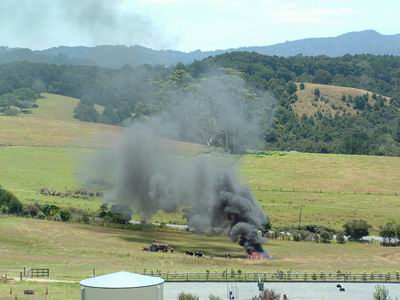Introduction
Air is a life supporting resource that needs to be protected. Although Northland's air is generally of a high quality, there is air pollution from human activities – particularly around urban centres such as Whangarei city.
Northland, like most other predominantly rural regions in New Zealand, is noted for its clear skies and fresh air. The prevailing south-westerly winds generally move air masses across the region fairly rapidly, although smoke and fog can accumulate during extended periods of cool, still weather in the winter months.
In order to protect our air, Northland Regional Council (NRC) has developed the Regional Air Quality Plan for Northland, which became operative in March 2003. The plan provides guidance to those using our air resource, in addition to specifying rules on what discharges into the air are permitted, authorised by resource consent, or prohibited.

Photo: Smoke pollution from burning farm waste
NRC has also been monitoring air quality in the region since 1996. The main purpose of air quality monitoring is to find out where air pollution might affect human health. NRC has an ongoing programme of air quality monitoring in places that are suspected of having occasional degraded air quality, or that may be affected by industrial emissions. The main pollutants measured are particulate Matter (PM10) and sulphur dioxide (SO2).
Air quality monitoring in the Northland region shows that some areas do occasionally experience poor air quality, especially areas next to busy roads that are subject to traffic congestion. Air quality issues in these areas can be exacerbated by periods of cold, calm weather during the winter months when pollutants can build up. Monitoring to date has shown that Whangarei city is the most likely area in Northland to have air pollution episodes.
In addition to regular monitoring programmes, NRC staff also undertake monitoring visits for consented activities that involve a discharge to air and attend environmental incidents where the main resource affected is air. The results of these monitoring visits and environmental incidents are discussed in more detail in the sections entitled "Annual Compliance" and "Environmental Incidents" respectively.
